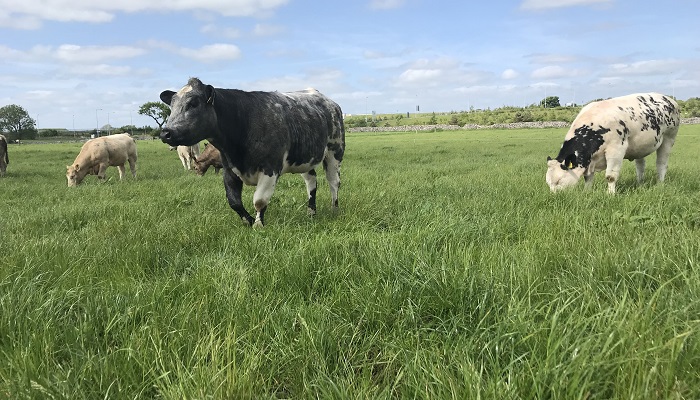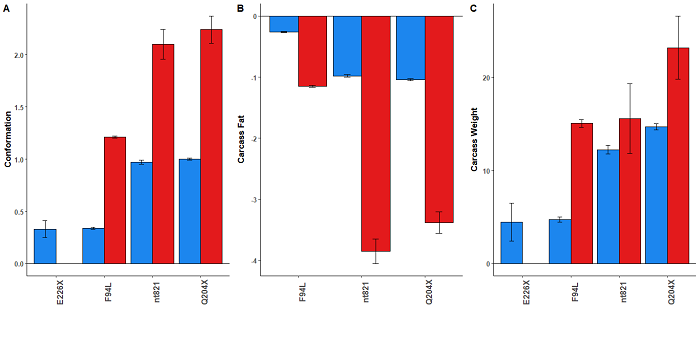03 April 2025
Understanding myostatin and its role in muscle growth and carcass traits in cattle

The myostatin gene, a key player in regulating muscle growth in cattle, has gained significant attention in the agricultural and livestock communities.
According to Dr. Cliona Ryan, a Geneticist at Teagasc who joined the recent Teagasc Future Beef webinar on ‘Breeding the ideal cow’, myostatin acts like a “brake pedal” on muscle development. When the gene functions correctly, muscle growth is controlled, resulting in normal-sized animals. However, when mutations (or physical breaks) occur in the myostatin gene, muscle growth accelerates, producing more muscled animals, often referred to as “double-muscled” animals.
Myostatin mutations and their impact
Dr. Ryan explained that mutations in the myostatin gene can vary in their effects. A partial break in the gene, such as the F94L mutation, is commonly found in Limousin cattle. Animals with this mutation typically show improved carcass traits without any impact on calving difficulty.
On the other hand, full breaks in the myostatin gene, such as the Q204X mutation which is mainly found in Charolais, nt821 mutation mainly found in Belgian Blues and E226X mutation in Shorthorns, can lead to significant increases in muscle mass. While these mutations enhance carcass traits, the nt821 and Q204X mutations are also associated with increased calving difficulty.
How myostatin is inherited
Cattle inherit one copy of each myostatin mutation from each parent. So for each myostatin mutation, every animal can either have:
- No mutations (two working copies of the gene) – normal muscling
- One mutation (one working copy, one mutated) – intermediate muscling
- Or two mutations (both copies mutated) – double muscling
Dr. Ryan explained that this matters because animals with one copy of a mutation have a 50% chance of passing that mutation onto their calves, and animals with two copies of a mutation will always pass one copy of the mutation onto their calves. That’s why it’s important to know the genetics of both the bull and the cow when breeding.
For example, if a bull has two copies of the nt821 mutation and the cow has none, the calf will inherit one mutated and one normal gene. These calves tend to have better muscling without the extreme calving risk. But if both parents pass on nt821, the calf will have two mutated copies, leading to extreme muscling and a much higher risk of calving difficulty.
Myostatin and carcass traits
While myostatin mutations can positively affect carcass weight, fat distribution, and conformation, the impact varies depending on whether animals carry one or two copies of the mutation. Typically, animals with no copies of the mutation are lighter with slightly fatter carcasses and poorer conformation. Those with one copy show improved traits, and animals with two copies see further improvements in carcass traits. The graph below quantifies the improvement in carcass traits that animals carrying one or two copies of the myostatin mutations on average have relative to animals with no copies of the myostatin mutations.
Figure 1. The average effect of carrying one or two copies of each myostatin mutation on carcass conformation, fat score, and weight, relative to animals carrying no copies of the mutation. Conformation and fat scores are measured on a 1 to 15 scale. (Blue denotes one copy of the mutation, red shows two copies of the mutation)

Conformation and fat scores are measured on a 1 to 15 scale. (Blue denotes one copy of the mutation, red shows two copies of the mutation)
The importance of understanding myostatin status
Despite the production positives, Dr. Ryan noted that not all myostatin mutations are suitable for every beef system. It’s essential for farmers to understand the potential for increased calving difficulty associated with mutations like nt821 and Q204X.
Geneticists recommend knowing the myostatin status of both bulls and cows before breeding to avoid complications like calving difficulty. Cows that carry two copies of mutations such as nt821 or Q204X may have narrower pelvises, making the birthing process more difficult. This risk is significantly increased if they are bred to a bull that also carries two copies of the same mutation, as the resulting calf will big double-muscled, making it harder to deliver through an already restricted birth canal.
For further insights, Dr. Ryan’s full presentation to the Future Beef webinar is available to view below:
Also discussed by ICBF’s Chris Daly, who featured on the webinar, farmers can access the myostatin status of their animals through their genomic evaluation profiles. Available for genotyped animals, Chris Daly explained that farmers can do so by visiting the ‘view profiles’ section of the ICBF website, selecting the ‘genomics’ tab and tend option to view the ‘myostatin + Polled’ option available.
Rose Goulding, Beef Programme Manager and NCBC, and Future Beef farmer, Ger McSweeney also featured on the webinar, where they provided an in-depth look at bull selection to improve herd genetics.
For more insights and to watch the full Future Beef webinar on ‘Breeding the Ideal Cow, visit here.
